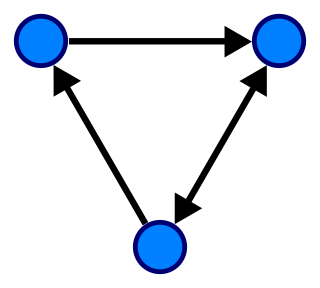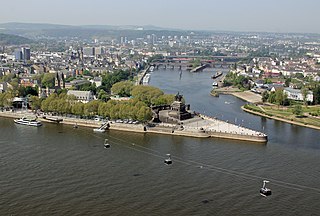
In mathematics, graph theory is the study of graphs, which are mathematical structures used to model pairwise relations between objects. A graph in this context is made up of vertices which are connected by edges. A distinction is made between undirected graphs, where edges link two vertices symmetrically, and directed graphs, where edges link two vertices asymmetrically. Graphs are one of the principal objects of study in discrete mathematics.
Reduction, reduced, or reduce may refer to:

In mathematics, random graph is the general term to refer to probability distributions over graphs. Random graphs may be described simply by a probability distribution, or by a random process which generates them. The theory of random graphs lies at the intersection between graph theory and probability theory. From a mathematical perspective, random graphs are used to answer questions about the properties of typical graphs. Its practical applications are found in all areas in which complex networks need to be modeled – many random graph models are thus known, mirroring the diverse types of complex networks encountered in different areas. In a mathematical context, random graph refers almost exclusively to the Erdős–Rényi random graph model. In other contexts, any graph model may be referred to as a random graph.
In mathematics, computer science, and logic, rewriting covers a wide range of methods of replacing subterms of a formula with other terms. Such methods may be achieved by rewriting systems. In their most basic form, they consist of a set of objects, plus relations on how to transform those objects.
In theoretical computer science, the subgraph isomorphism problem is a computational task in which two graphs G and H are given as input, and one must determine whether G contains a subgraph that is isomorphic to H. Subgraph isomorphism is a generalization of both the maximum clique problem and the problem of testing whether a graph contains a Hamiltonian cycle, and is therefore NP-complete. However certain other cases of subgraph isomorphism may be solved in polynomial time.

In computer science, a graph is an abstract data type that is meant to implement the undirected graph and directed graph concepts from the field of graph theory within mathematics.
In category theory, a branch of mathematics, a pushout is the colimit of a diagram consisting of two morphisms f : Z → X and g : Z → Y with a common domain. The pushout consists of an object P along with two morphisms X → P and Y → P that complete a commutative square with the two given morphisms f and g. In fact, the defining universal property of the pushout essentially says that the pushout is the "most general" way to complete this commutative square. Common notations for the pushout are and .
In computer science, an abstract semantic graph (ASG) or term graph is a form of abstract syntax in which an expression of a formal or programming language is represented by a graph whose vertices are the expression's subterms. An ASG is at a higher level of abstraction than an abstract syntax tree, which is used to express the syntactic structure of an expression or program.
In computer science, graph transformation, or graph rewriting, concerns the technique of creating a new graph out of an original graph algorithmically. It has numerous applications, ranging from software engineering to layout algorithms and picture generation.

In computer science, confluence is a property of rewriting systems, describing which terms in such a system can be rewritten in more than one way, to yield the same result. This article describes the properties in the most abstract setting of an abstract rewriting system.
A model transformation language in systems and software engineering is a language intended specifically for model transformation.
Graph Rewriting and Transformation (GReAT) is a Model Transformation Language (MTL) for Model Integrated Computing available in the GME environment. GReAT has a rich pattern specification sublanguage, a graph transformation sublanguage and a high level control-flow sublanguage. It has been designed to address the specific needs of the model transformation area. The GME environment is an example of a Model Driven Engineering (MDE) framework.
In theoretical computer science, a transition system is a concept used in the study of computation. It is used to describe the potential behavior of discrete systems. It consists of states and transitions between states, which may be labeled with labels chosen from a set; the same label may appear on more than one transition. If the label set is a singleton, the system is essentially unlabeled, and a simpler definition that omits the labels is possible.

GrGen.NET is a software development tool that offers programming languages that are optimized for the processing of graph structured data. The core of the languages consists of modular graph rewrite rules, which are built on declarative graph pattern matching and rewriting; they are supplemented by many of the constructs that are used in imperative and object-oriented programming, and are completed with language devices known from database query languages.
In computer science, double pushout graph rewriting refers to a mathematical framework for graph rewriting. It was introduced as one of the first algebraic approaches to graph rewriting in the article "Graph-grammars: An algebraic approach" (1973). It has since been generalized to allow rewriting structures which are not graphs, and to handle negative application conditions, among other extensions.
In mathematics, an adhesive category is a category where pushouts of monomorphisms exist and work more or less as they do in the category of sets. An example of an adhesive category is the category of directed multigraphs, or quivers, and the theory of adhesive categories is important in the theory of graph rewriting.
A term graph is a representation of an expression in a formal language as a generalized graph whose vertices are terms. Term graphs are a more powerful form of representation than expression trees because they can represent not only common subexpressions but also cyclic/recursive subexpressions.
In mathematics, especially in algebraic topology, the homotopy limit and colimitpg 52 are variants of the notions of limit and colimit extended to the homotopy category . The main idea is this: if we have a diagram
In computer science, an attributed graph grammar is a class of graph grammar that associates vertices with a set of attributes and rewrites with functions on attributes. In the algebraic approach to graph grammars, they are usually formulated using the double-pushout approach or the single-pushout approach.




